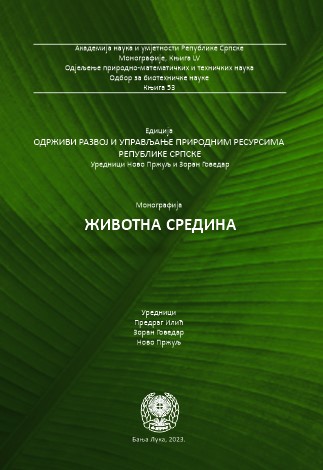The importance of forests in the environment
DOI:
https://doi.org/10.7251/EORU2309579KKeywords:
Forest ecosystems, environment, importance of forests, climate change, forest protectionAbstract
The complexity and interdependence of all factors of forest ecosystems is reflected in the general state of the environment. The forest moderates air temperature fluctuations by 1.5–4° C, and creates a more favorable temperature regime in the soil. Atmospheric precipitation in the forest is absorbed by the forest litter, which slows down surface runoff and prolongs the period of water infiltration. The wind speed in the forest is 30% lower than the wind speed in the open space, and wind protection is manifested in a radius 3–5 times greater than the average height of the trees. Forest vegetation absorbs carbon dioxide from the atmosphere and uses it for its growth in the process of photosynthesis. This process leads to a decrease in the concentration of carbon dioxide in the atmosphere and contributes to reducing the negative effects of the greenhouse. In this way, forests influence the prevention of the occurrence of unfavorable scenarios of surface global warming, which may manifest with an increase in temperature by as much as 5.8° C. Forests play a key role in maintaining the oxygen-carbon dioxide balance because they annually release 9–13 t/ha of CO2, and bind 6–18 t/ha of CO2. A monofunctional approach to forest ecosystems, where forests are viewed exclusively through the prism of the production (assortment) function, still exists it burdens the perception and evaluation of numerous ecological and social functions. However, even today, around 1.15 billion hectares of forests (30%) are used primarily for the production of wood and non–wood forest products. Some of the ecological potential of forest complexes is reflected in the absorption of dust particles, sulfur dioxide, the release of oxygen, the binding of carbon dioxide, and the release of phytoncides. One hectare of forest absorbs 30 to 70 tons of dust annually. Coniferous forests absorb 30−35 tons of dust annually, and deciduous forests 50-76 tons. A hectare of forest absorbs about 100 kg of SO2, releases 3 to 11 t of oxygen and binds 4 to 15 t of CO2 per day. Thanks to the phytoncide action, a cubic meter of forest air contains 250 to 300 times less bacteria than city air. Forest ecosystems contain more carbon per unit area than any other terrestrial ecosystem. Amounts of soil organic carbon in the upper 30 cm of soil vary from 1.7 to 4.2 kg C.m-2 for organic layers and from 5.0 to 9.5 kg C.m-2 for mineral layers. The layers of the forest mat and the surface horizons of the forest soil of coniferous forests are large acceptors of heavy metals. Risks caused by numerous disruptions of natural processes (climate change, drought, storm winds, erosion, fires, etc.) have a major impact on the sustainable development of natural resources and threaten the environment, infrastructure, forest ecosystems, agricultural production, water availability and public health. The threat of forests, disappearance, degradation and drying of forests affect the reduction of the impact of the forest on the balance in the biosphere, the reduction of the volume of biomass production and the endangerment of the environment. Existing forests continue to suffer the direct and indirect effects of human action, whether from deliberate deforestation, damage from numerous conflicts and wars, to the careless actions of mining companies and illegal activities, or damage from legal and illegal logging. Around the world, severe forest fires have not only shown the combined effects of careless human activities in and around forests and global warming, but have also shown how quickly forests can be lost. In Europe, almost 45.000 forest fires occur every year, covering of 500.000 ha. The Balkan Peninsula is one of the areas with the highest risk of drought. Frequent and long-lasting drought leads to a decrease in the vitality and gradual deterioration of forests due to a decrease in soil moisture, the appearance of climatic extremes, a shortening of the vegetation period, difficult regeneration, a decrease in resistance to harmful biotic factors (the appearance of epiphytophytes of pathogenic fungi or gradation of economically harmful insects), all of which can lead to the drying of forests on a wider scale. For the environment, the general utility functions of forests related to tourist-recreational, health, water protection, historical, cultural and other values are particularly important. These functions are reduced due to the degradation and devastation of forests because these processes affect the increase in the intensity of climate change, the reduction of biodiversity, the reduction of renewable energy sources, the decline of economic development, the occurrence of erosion and flood, increase in atmospheric CO2, decline in quality of life, occurrence of diseases, etc. The complexity of the relationship between forest ecosystems and the environment needs to be viewed from multiple aspects and understood through an ecological, economic and social interconnected system. Understanding the impact of the forest requires the study of all characteristics of forest ecosystems, such as pedological, phytocenological, typological and other research. The destruction and fragmentation of urban forests, the loss of certain valuable trees, as well as the loss of fauna, threaten the ecological integrity and functioning of natural ecosystems, which directly affects the quality of life in urban areas. Domestic and international legislation and strategic decisions related to forest ecosystems are closely related to similar documents related to the environment. These documents mainly indicate the need to increase forest cover, preserve existing forests, multifunctional use of forest resources and sustainable development.
